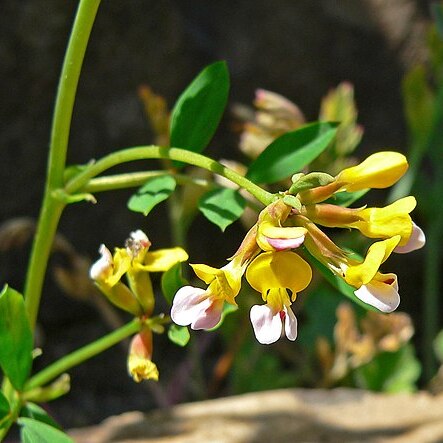Herbs, annual or perennial, subshrubs, or rarely shrubs. Leaves pinnate or palmate, usually sessile, 3-9-foliolate; stipules absent, or reduced to small dark glands; leaflets sessile or on very short petiolules, most species with 5 leaflets, 3 crowded at apex of leaf rachis, 2 at base; basal pair similar to apical ones or often differing in shape and stipulelike. Inflorescence an axillary, pedunculate, 1-to many-flowered umbel; peduncle with a sterile bract usually represented by a conspicuous leaf with 1-3(-5) leaflets; flower-subtending bracts reduced to small dark glands (rarely with a herbaceous blade) or absent; bracteoles usually absent, when rarely present then glandular. Calyx campanulate or trumpet-shaped; teeth 5, subequal or distal longer, sometimes connate into 2 lips. Corolla yellow (often turning green in herbarium), pink, violet, brown, or white. Vexillary stamen free. Ovules numerous or several; style entire [or with a small toothlike appendage]; stigma terminal. Legume linear to ovoid, straight or incurved, terete or flattened, longitudinally dehiscent [indehiscent in 1 species outside China]. Seeds subglobose or lenticular, smooth, rarely verrucose.
Annual to perennial, procumbent to erect herbs or rarely subshrubs. Lvs pinnately 5-foliolate (rarely 4-foliolate but not in N.Z. spp.); leaflets entire; principal lateral veins conspicuous or not; stipules minute or 0. Infls axillary, usually umbellate, 1-many-flowered; bracts often 3-foliolate, subtending umbels; bracteoles usually 0. Calyx teeth 5, subequal or lower longer, rarely connate into 2 lips. Corolla deciduous. Vexillary filament free, the remainder connate; anthers uniform. Style glabrous; stigma terminal or lateral. Pod 2-valved, straight or slightly curved, dehiscent, not armed, many-seeded; seeds estrophiolate, smooth and rounded in N.Z. spp.
Cal campanulate or obconic, the elongate teeth subequal; pet clawed; standard obovate, not auriculate, its claw generally with thickened, infolded margins; keel-pet usually beaked; stamens 10, diadelphous; some of or all the filaments dilated at the tip; ovary sessile; pod several-seeded, dehiscent, oblong to linear, terete (in our spp.), flattened, or 4-angled; herbaceous or suffrutescent plants with pinnately compound, 1–5-foliolate lvs and solitary or umbellate fls. (Acmispon, Hosackia) 100, mainly N. Temp.
Corolla yellow, pink, cream or white, glabrous or rarely (in Macaronesia and Morocco) the standard and (very rarely) also the wings pubescent, free from the stamens; standard ± oblong-obovate, wedge-shaped at the base with infolded thickened margins; wings clawed, the blade oblong, auriculate, laterally pouched; keel curved, pointed or beaked with free claws.
Leaves sessile or with a very short petiole, usually with 5, rarely with 3–4, leaflets (or elsewhere occasionally more); leaflets petiolulate, the lower pair at the base of the rhachis and resembling stipules; stipules reduced to dark glands, sometimes inconspicuous, or absent; stipels absent.
Pod usually cylindrical, straight, linear, usually septate within, dehiscent into 2 valves (except in L. benoistii, from Morocco, with an indehiscent fruit, and in the Mediterranean L. edulis with the fruit dehiscent ventrally), the valves often becoming twisted.
Ovary sessile or shortly stipitate, glabrous (outside the Flora Zambesiaca area sometimes strigulose or hairy), subcylindrical, multi-ovulate; style bent upwards at the base, glabrous, but papillose, rigid.
Flowers in axillary usually pedunculate umbels with a 1–3-foliolate foliage leaf, rarely umbels reduced to one flower and resembling solitary flowers.
Vexillary stamen free, the other 9 with the filaments united into a sheath; free parts of at least the 5 longer filaments widened at the tip.
Calyx tubular or narrowly campanulate, subequally 5-toothed or the lowest tooth longest or the teeth in 2 lips.
Seeds ellipsoid, subreniform or subglobular, with a small, median hilum.
Annual or perennial herbs, subshrubs or dwarf shrubs.

